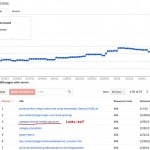SEO refers to search engine optimization, which is the practice of
optimizing website content for search engines. Basically, it means
implementing certain techniques that will make it easier for search
engines to understand what your site is about so that they can show it
in the results when someone searches for a particular word or phrase
online (note also that SEO focuses on organic search results, not on
paying for ads).

When we’re talking about search engines, we’re really talking about
one search engine for all intents and purposes. Google is not the only
search engine out there, but it does have the greatest share of the
search engine market. It has 66.7% of the market, whereas the runner-up
(Bing) has 16.3%, Yahoo has 12.2%, and Ask has 3%, according to comScore (AOL, in case anyone still remembers it, has 1.8%).
Why is SEO Important?
SEO is important because most of us rely on online searches to help
us find what we’re looking for. If we type in a search like “sustainable
business practices,” we expect to find results that are relevant. We
expect to find a site that provides us with information about
sustainable business practices.
Your prospective clients are doing the same thing. They’re typing in
search queries related to your services. You want to make sure that when
they do that, they will see your website in the search results. After
all, the first step in getting people to read your blog is to make sure
that they can find it in the first place!
How Do I Implement SEO?
To effectively use SEO involves understanding that each of your
website pages and blog posts should be focused on a keyword, and that
keyword should be used in certain places on your blog.
For example, the page title is a high-value location for SEO because
the search engines use this as an important clue when deciding what
pages to serve up in the search results. In the case of this blog post,
the page title – “What is SEO?” – indicates that this post will talk
about what SEO is. As a result, it should show up in search results for
“what is SEO?” (maybe that’s how you found this post!).
Here are a few best practices when it comes to SEO and blogging that you can easily implement:
- One keyword per post: Try to optimize each of your posts around one keyword. Instead of targeting multiple keywords in one post, keep each of your blog posts tightly focused on one topic.
- Keywords in page titles: As was just discussed, this is an important one! Be sure to include your keyword in the title of your blog posts.
- Keywords in the URL: The URL is the link for your blog post. Having the keyword that you’re targeting in the URL is a good practice.
- Keywords in the meta descriptions: The meta descriptions are the short bits of text that appear in the search results. Although these do not directly impact your search results (Google has said that it’s not part of their search algorithm), they are important for users. A well-written meta description that uses your keyword can influence a user to click on your link.
- Keywords in image alt descriptions: You can include descriptions for the images on your blog. Since the search engines have a difficult time knowing what an image is showing, these descriptions will tell the search engines what your image is about.
If you’re using WordPress, I recommend that you use the WordPress SEO by Yoast plugin. It will help you to optimize your post from within your WordPress dashboard, and it’s quite easy to use.
How Do I Choose the Right Keywords?
Keyword research is an art unto itself. Be aware that a tremendous
amount of data and paid tools are available online to help you learn
about and do keyword research, and what I offer here are just a couple
of steps to get you started.
First, start by thinking about what your post will be about. Come up
with a few keywords that capture the topic of your post. Be sure to put
yourself in the mind of your ideal client and use the search terms that they might use. If you’re using Google Analytics, you can take a look at your traffic sources to get some ideas.
Then use Google’s Keyword Tool
(you’ll need to sign up for a free Adwords account). Type in the
keywords that you’re thinking of using, and be sure to check “[exact]”
or “phrase” as the Match Type because you’ll get the most relevant
results for your keyword. Click on the “Keyword Ideas” tab and then look
at the search results. Look at both the “Competition” (how competitive
the search term is) and “Local Monthly Searches” (this represents search
volume in the U.S.). The sweet spot that you’re looking for is low
competition and high search volume – this means that a lot of people are
searching for this term yet there’s not a lot of competition for it.
When you find that keyword, it should be a good one for you to use.
Getting Started with SEO
If you use these tips to find good keywords to target and then follow
a few best practices to optimize your posts, you’ll be well ahead of
those who are not optimizing their sites effectively.
However, it’s important to remember that good SEO is about more than
just keywords. In fact, if you’re a small business owner, there’s a lot
that you should know about SEO, especially, about the role of good content. Ultimately, writing for your audience is more important than focusing on keywords.
If you’re interested in learning more about SEO, check out the Moz Beginner’s Guide to SEO. It’s a great resource, and you’ll learn a lot!
Information Credit -







